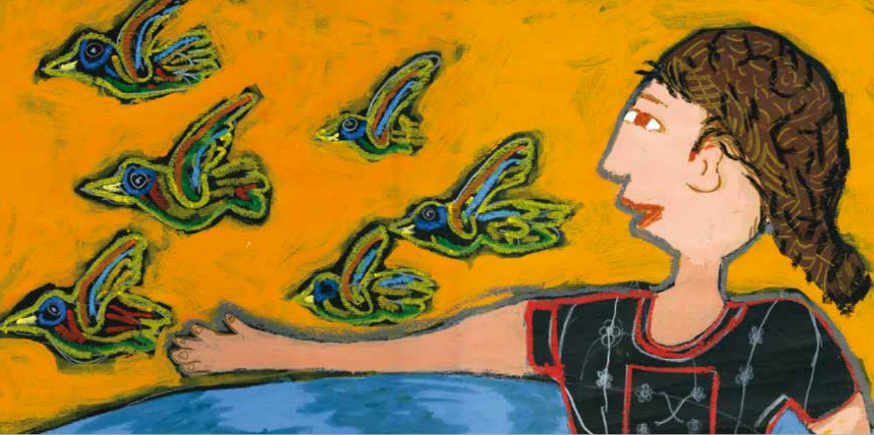Chupa Ladxiduá: The inter-semiotic translation of a book into a digitalized object-book to promote Zapotec literacy
Inspiration: The book Chupa Ladxiduá by Irma Pineda

My final project is inspired in the book Chupa Ladxiduá -My heart is two- written by the Zapotec poet Irma Pineda and published in 2018 by Alas y Raíces. This book is a collection of 60 poems written along the time, which mean to be addressed to children in this book, however, the topics are so diverse and deep that actually is a book for everybody interested in the quotidian life, with both, it´s beauties and difficulties- of this indigenous culture and its expression in the form of written language. The book is divided in four sections: 1) Diidxa´ -the word- 2) Guidxi -the town-, 3) Guendarixhana -maternity-, 4) Ni napa xi che’ -exile-. 5) Ni que guidxela -missing people-. The book is bilingual, therefore is written in Spanish and Zapotec side by side. In this way children and adults can learn and compare both languages. Each poem is illustrated by beautiful drawings made by Zapotec children from Juchitán, a city in the Isthmus of Tehuantepec where Irma was born.

Sólo lanzaré mis palabras / Nisi chi gundaa stiidxa, Iván Castillejos Ruiz, 11 years (Pineda, 2018: 214)
The inter-semiotic translation
For my final project I am working on the inter-semiotic translation of this book into a digitalized object-book -wearable- to promote Zapotec literacy. The main idea implies to record those poems in audio and store them into a PCB board which is going to be placed inside of a heart made with resin and which you can use as a necklace or just having it in your hand to play with it. In order to access to the content, you have to talk to the heart by saying “Xinu ladxidó loca”, a traditional way to say hello in Zapotec which means “How your heart is feeling”. Once the heart is on you can access to the poems and listen them with headphones, in both, Zapotec and Spanish.
The interactive part of the project
Indeed, this is not one but two hearts, just as the name of the book; Chupa Ladxidua´ -My heart is two-. Therefore, I will produce two hearts having the same functions. The idea is that those hearts are going to be connected via Bluetooth and Wi-fi. In this way, it can be used as a game between parents and children or partners to promote communication and Zapotec literacy. When one heart is on, the other illuminates. After this sign you can send a poem to the other heart. When the poem is listened, you can make the two heart change colors depending on the felling that the poem produced in yourself. For example, if is happiness you can make it to turn red, if is sadness or melancholy you can make it to turn blue. The later functionality means to be a simple semiotic system to share basic felling between the two heats that are quite close in space, for example parents and children living in the same house -bluet hood- or that are very far away, for example migrant in U.S that left behind their love ones -Wi-fi-.

Scaling the project
In the future I would like to develop an indigenous robot who can speak and translate Zapotec to Spanish. I also want this robot to contain the Zapotec pluriverse. In this way I want bot only to promote linguistic revitalization but also cultural revitalization from a broad perspective. For this am inspired by the concept of cosmotehcnics proposed by Yuk Hui: “it is the unification of the cosmos and the moral through technical activities, whether craft-making or art-making. There hasn’t been one or two technics, but many cosmotechnics. What kind of morality, which and whose cosmos, and how to unite them vary from one culture to another according to different dynamics. I am convinced that in order to confront the crisis that is before us – namely, the Anthropocene, or the intrusion of Gaia (Latour and Stengers), or the “entropocene” (Stiegler), all presented as the inevitable future of humanity – it is necessary to reopen the question of technology, in order to envisage the bifurcation of technological futures by conceiving different cosmotechnics.” (Hui, 2017: 7)
Dedication
With this project is a way to honor my grandmother´s memory. she was a Zapotec who did not want to teach her children Zapotec because she was afraid that they would be rejected by society and in the school. However, all of them manage to learn Zapotec by their own way until Zapotec became the main language spoken in her household. My mother did not teach me Zapotec either because of the same reason. However now is my tourn to try to learn my ancestor’s language. I am doing so together with my partner, my brothers, and my nephew; little by little is becoming more common the Zapotec language when we meet at my parents’ house. I hope this project will inspire more people to learn their mother tong languages and to understand which pluriverse they come from in order to be able to be proud of it, to maintain it and to redesign it when need it with the help of new digital technologies such as the ones we use in the Fab Academy.
Materials
| Qty | Description | Price | Link |
|---|---|---|---|
| Material one | 22.00 $ | https://amazon.com/testoe | Order many |
| Material two | 22.00 $ | https://amazon.com/testoe | |
| Material three | 22.00 $ | https://amazon.com/testoe | |
| Material four | 22.00 $ | https://amazon.com/testoe |